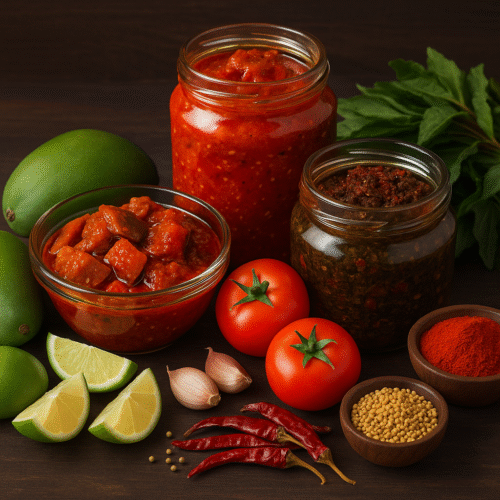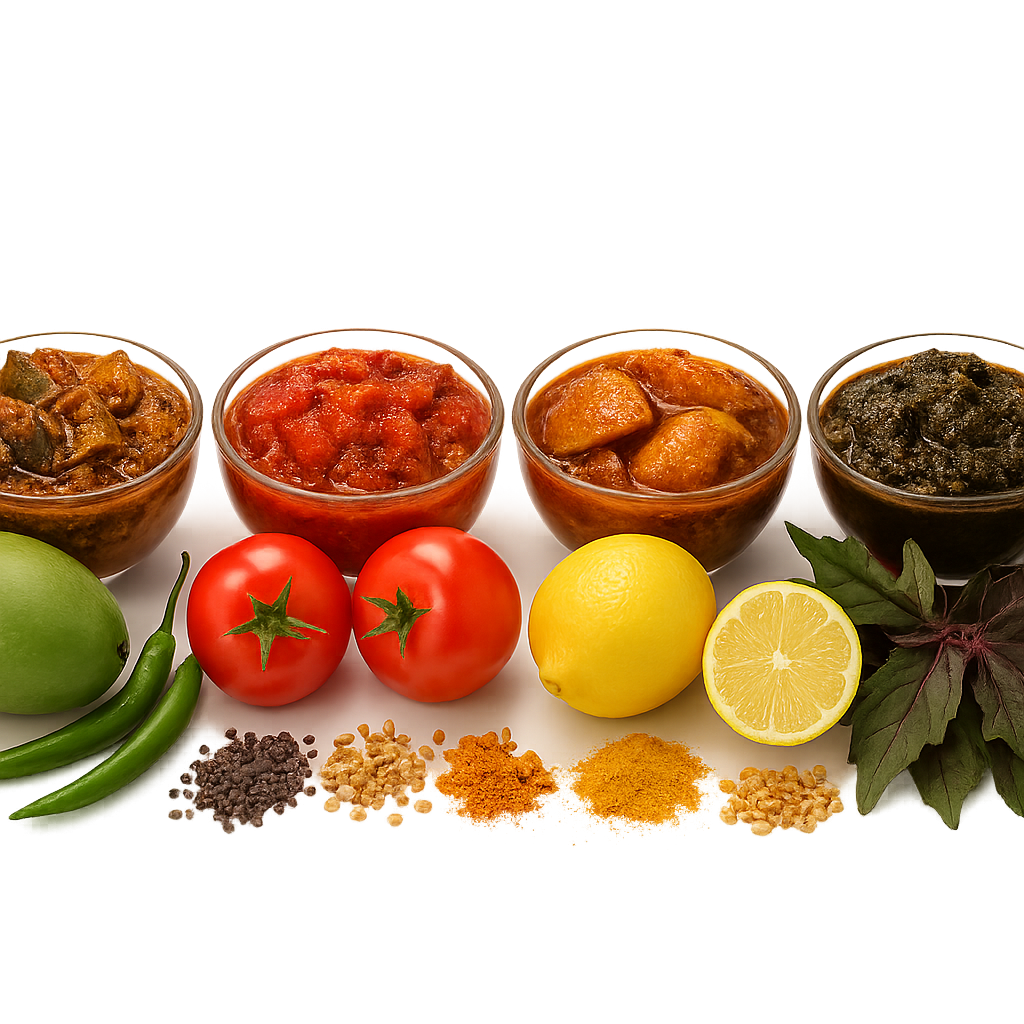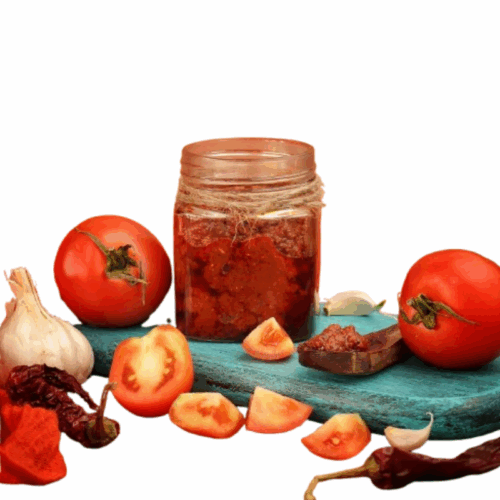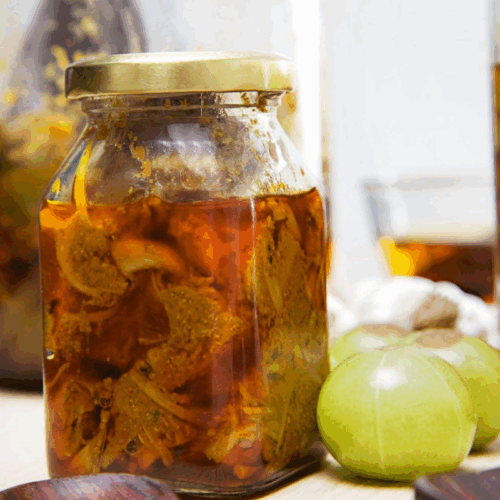The Art of Crafting Traditional Andhra Pickles
Every Jar Tells a Story of Spice, Sun, and Soul

Introduction
In every Andhra household, there’s a corner of the kitchen reserved for magic — a row of Bharanis (ceramic pickle jars) lined up like treasure chests. These aren’t just condiments. They are legacies, preserved in oil and spice. The art of making traditional Andhra pickles — or “uragaya” as locals call it — goes beyond culinary skills. It is an emotion, a ritual, and a symbol of cultural identity.
From the fiery Avakaya to the tangy Gongura, pickles play a sacred role in Andhra cuisine. A typical Andhra meal feels incomplete without that spicy punch on the side. But more than just taste, it’s the tradition behind them that makes these pickles so iconic — passed down from generation to generation, crafted with care, patience, and love.
1. The Soul of Andhra Pickles – Ingredients
Every memorable Andhra pickle begins not in the kitchen, but on the land — in sun-scorched fields, backyard trees, and spice-laden marketplaces. The soul of these fiery, fragrant pickles lies in their ingredients — raw, rustic, and intensely regional. There’s no room for shortcuts here. In a traditional Andhra household, every element is handpicked, seasonally harvested, and revered with respect.
🌶️ Guntur Red Chillies – The Fire of Andhra
Known across the globe for their vibrant color and explosive heat, Guntur chillies are the backbone of most Andhra pickles. These chilies are sun-dried until they reach a deep crimson hue and then ground to a fine, potent powder. It’s not just about heat — Guntur chillies bring flavor complexity, warmth, and that unmistakable red tint that makes the pickle not only taste bold but look bold.
🥭 Raw Mangoes – Nature’s Tangy Gift
For Avakaya and other mango-based pickles, raw mangoes are more than just fruit — they are the heroes. Harvested when they are still green and firm, these mangoes are cut with precision and sun-dried to eliminate moisture. The ideal mango is fibrous, sour, and thick-skinned — capable of withstanding weeks of fermentation without turning mushy. Timing is everything; a few days early or late in harvest can alter the pickle’s texture and sourness.
🌿 Gongura Leaves – Tangy, Earthy, Unmistakably Andhra
Gongura (sorrel leaves) holds a pride of place in Andhra kitchens. Its naturally tangy flavor pairs beautifully with spice, making it perfect for pickling. The leaves are carefully washed, dried, and sautéed before being blended with a fiery spice mix. Gongura pickles are iconic, often standing alone without the need for any fruit or vegetable — just the power of the leaf itself.
🧄 Spices & Preserving Agents – Taste Meets Tradition
Pickling is not only about flavor but also about preservation. Ingredients like garlic, tamarind pulp, rock salt, fenugreek seeds (menthulu), and mustard seeds (avalu) serve dual roles:
-
Garlic adds pungency and warmth.
-
Tamarind gives depth and a sour-sweet balance.
-
Rock salt draws out moisture and prevents microbial growth.
-
Fenugreek and mustard offer bitterness and astringency that balance the bold spice while acting as natural preservatives.
🛢️ Cold-Pressed Sesame Oil (Nuvvula Nune) – The Liquid Gold
No Andhra pickle is complete without a generous pour of cold-pressed sesame oil. Known locally as Nuvvula Nune, this oil does more than just bind the ingredients — it seals in the flavor, protects the pickle from spoilage, and deepens the taste as it ages. Cold-pressing preserves the nutty aroma and nutritional integrity of the oil, giving the pickle a rich base and extended shelf life.
🌱 A Philosophy of Purity and Patience
Traditional Andhra pickle-making embraces a zero-chemical, zero-compromise philosophy. There are no preservatives, no additives, no shortcuts. The flavors emerge slowly, over weeks — not from machines or enhancers, but from nature and centuries-old wisdom passed from mother to daughter, from kitchen to kitchen.
These ingredients don’t just go into a jar — they are carefully layered stories of the land, the weather, and the culture. It’s why a bite of Avakaya or Gongura can transport you straight to an Andhra summer afternoon.
2. The Traditional Process – More Than Just Cooking
Crafting a traditional Andhra pickle is not simply about mixing ingredients; it’s a sacred ritual, a process honed over generations that blends intuition, science, and soul.
It begins with nature’s first tool — the sun. During early summer, the blazing Andhra sun becomes an essential participant in the process. Raw mango cubes or Gongura leaves are meticulously laid out on clean cotton cloths, often on rooftops or courtyards, where they absorb the sun’s intense heat. This sun-drying process is crucial: it draws out moisture, enhances natural flavors, and ensures that the ingredients stay preserved for months without refrigeration.
Once sun-dried, the magic of spices takes over. Mustard seeds, cumin, fenugreek, asafoetida — each is lightly roasted on an iron pan until fragrant, releasing oils and aromas that signal readiness. There are no grinders or food processors here — only stone grinders (rubbu rolu) or mortar and pestles, which preserve the coarse, grainy texture that defines Andhra pickles. The act of hand-pounding isn’t just about tradition; it locks in aroma and integrity, unlike machine-ground powders.
Next comes the heart of the process: mixing. Dried ingredients are slowly folded into the freshly roasted spice blends, with generous streams of cold-pressed sesame oil binding the mixture. And here’s where precision is everything — no moisture must touch the batch. Even a drop of water can turn an entire jar rancid. The process is often done in large batches, under watchful eyes, with clean hands and a near-ritualistic seriousness.
Finally, the prepared mixture is spooned into ceramic or stone jars, called bharanis, and sealed tight. These jars are left to rest in cool, dark corners — where over weeks and months, the pickles ferment naturally, absorbing deeper flavors with every passing day.
This is not fast food. It’s slow-crafted art, where every step carries the imprint of patience and perfection.
3. Passed Down by Ammamma – The Generational Touch
In the heart of every Andhra kitchen lives a story — not just of spice and sourness, but of love passed from generation to generation. And often, at the center of it all, is Ammamma (grandmother) — the true guardian of pickle wisdom.
Ask any Andhra native about their favorite pickle, and you’ll likely hear:
“Ammamma chethi Avakaya” — Grandma’s handmade mango pickle.
Why? Because her version isn’t just about flavor — it’s about memories soaked in oil and spice.
Pickle-making season, especially in April and May when mangoes arrive in abundance, is more than a kitchen activity — it’s a family festival. Grandmothers lead the charge with decades of experience etched into their fingertips. Their measurements aren’t taken from recipe books but from instinct — a pinch of this, a handful of that, always just right.
Children sit cross-legged on the floor, peeling mangoes and garlic. Mothers dry them under the sun. Cousins laugh and sneak spicy bites. All while Ammamma stirs roasted spices, reciting stories from her childhood — sometimes about how her own mother made pickles without electricity, or how the first batch of the season was always offered to the gods before anyone else could taste it.
The prepared pickle, once mixed and blessed with tradition, is stored in bharanis — heavy ceramic jars with wide mouths and tight lids. These jars sit quietly in the darkest corners of the kitchen, slowly maturing, turning sharper and richer with each passing day.
And months later, when the family opens that jar and the aroma escapes, it’s more than just food on the table. It’s the return of a memory. It’s like being hugged by Ammamma again.
Because in Andhra homes, pickles aren’t just preserved vegetables — they are preserved emotions. And no recipe can replace the warmth of a grandmother’s hand.
4. Varieties That Define Andhra
While Avakaya remains the crown jewel, Andhra’s pickle landscape is rich, varied, and deeply regional, with every household favoring a different star ingredient depending on the season and local produce. These pickles go beyond mango — each bringing its own flavor profile, texture, and legacy.
🥭 Avakaya – The King of Andhra Pickles
Crafted with raw mangoes, ground mustard powder, red chilli powder, rock salt, and sesame oil, Avakaya is the benchmark of Andhra pickle culture. It’s fiery, bold, and pungent — with each mango cube bursting with layered heat. Prepared at the height of mango season, this pickle matures in bharanis for weeks and is often enjoyed year-round with hot rice and ghee.
🍃 Gongura Pickle – Tangy & Textured
Made from sorrel leaves, Gongura pickle is an Andhra signature with a distinct tartness and fibrous bite. The leaves are sautéed and blended with spices, creating a pickle that balances sharp acidity with deep earthy undertones — a favorite in both Coastal Andhra and Telangana.
🍅 Tomato Nilava – The Sun-Dried Wonder
This variety uses sun-dried tomatoes, which intensify in flavor and gain a chewy texture that holds the pickle’s spices beautifully. Known for its long shelf life, Tomato Nilava is both practical and punchy, offering a perfect mix of tang and umami.
🍈 Usirikaya Pickle – Tart & Nutrient-Packed
Usirikaya, or gooseberry, brings a sharp, vitamin-rich profile. Lightly cooked or sun-dried, these sour green fruits are blended with traditional spices to create a pickle that is not only tasty but also packed with immunity-boosting benefits.
🫚 Allam Pachadi – Sweet Heat in a Jar
A unique pickle-chutney hybrid, Allam Pachadi is made with fresh ginger, jaggery, and chillies. The result is a sweet-spicy explosion that pairs beautifully with breakfast items like dosa or pesarattu. Its sticky, smooth consistency and fiery sweetness make it stand out.
🌾 Nuvvula Karam – Dry Sesame Spice Magic
This dry mix pickle made with roasted sesame seeds, red chillies, garlic, and sometimes coconut, is more of a spice blend but treated like a pickle in Andhra households. Served alongside hot rice and ghee, it offers richness and aroma that’s deeply comforting.
Even more fascinating is how each region within Andhra Pradesh — from the coastal belt to Rayalaseema and Telangana — interprets the same recipe differently, adjusting spice levels, oil usage, or drying techniques, making the same pickle taste wonderfully unique across districts.
5. The Science Behind the Spice
Though the pickle may seem like a simple side dish, it is in fact a marvel of natural food science, refined over centuries of practice in traditional Andhra kitchens.
The process begins with natural fermentation, especially in mango and gooseberry pickles, where time allows the ingredients to develop gut-friendly probiotics, aiding digestion and boosting immunity. This isn’t artificial — it’s nature doing the work, with time, salt, and air.
Salt and spices aren’t just for taste. They act as natural antimicrobials, creating an environment hostile to spoilage while encouraging the growth of beneficial microbes. Red chilli, mustard, and fenugreek also have antimicrobial and antifungal properties, which help preserve the pickle without refrigeration.
Finally, cold-pressed sesame oil plays a critical role. It forms an airtight layer, preventing moisture and oxygen from entering — two main causes of spoilage. This oil doesn’t just preserve — it carries and deepens the flavors as the pickle matures.
The process relies on a delicate balance of pH, temperature, and time — not created in labs but perfected in homes through generational wisdom. Each batch is a science project guided by instinct, not instruments.
6. Modern Packaging vs Traditional Charm
In today’s fast-paced world, where convenience often trumps culture, Andhra pickles have found their way into ready-to-eat jars and branded pouches. This rise in commercial production caters to growing demand — especially among NRIs and urban food lovers.
Modern pickle brands use vacuum-sealing, tamper-proof caps, and export-grade hygiene to make pickles safer, longer-lasting, and market-friendly. Some have even taken traditional recipes global, adding barcodes and nutritional labels to what was once only packed in clay.
But despite innovation, there remains a silent nostalgia for the homemade batch — the kind that’s fermented in a sunlit corner of the kitchen, stirred with love, and sealed with the wisdom of grandmothers.
Replicating that handcrafted essence at scale is difficult. Commercial processes may nail the flavor, but often miss the soul — the grainy texture from hand-ground spices, the patient layering of oil, or the aging that can’t be rushed.
Because for many, the true taste of Andhra pickle still lives in that old ceramic jar, quietly waiting in a corner, untouched by machines and rich with memory.
7. Andhra Pickles Go Global
Once tucked away in the back shelves of Andhra kitchens, pickles like Avakaya, Gongura, and Usirikaya have now made their way onto global tables, traveling across oceans with migrating families, packed carefully in suitcases next to love and longing.
Today, Andhra pickles are not just homemade delicacies; they’re commercially exported to countries like the United States, the United Kingdom, Australia, and the UAE, where large Indian diaspora communities crave the taste of home. For many NRIs, a spoonful of Gongura or a tangy bite of Avakaya does more than satisfy hunger — it evokes emotion, memory, and identity.
But the journey doesn’t stop with nostalgia. In recent years, these pickles have entered the spotlight of global food innovation. No longer confined to being a side dish for rice or rotis, Andhra pickles are now appearing in unexpected places:
-
Avakaya as a tangy layer in grilled sandwiches
-
Gongura smeared inside a soft taco
-
Tomato Nilava as a pizza base sauce twist
-
Nuvvula Karam sprinkled on avocado toast or fries
-
Allam Pachadi as a dip for cheese boards or spring rolls
This fusion wave has introduced Andhra pickles to a whole new generation of global food lovers, many of whom are tasting it for the first time — not in an Indian home, but in a food truck, bistro, or Instagram reel. Chefs and home cooks alike have started rebranding these pickles as “gourmet Indian ferments” — artisan, bold, and flavor-forward.
And yet, through every reinvention, they remain true to their roots — fermented, fiery, and full of history. Andhra pickles may travel far, but they always carry the soil of their origin within them.
Conclusion
The art of crafting traditional Andhra pickles is not merely a process of preservation — it is an act of storytelling, a form of legacy. From the scorching sun that dries mango slices, to the patient grinding of mustard seeds, to the whispered instructions of a grandmother, every step is rich with purpose and emotion.
In each jar, there’s more than just spice. There’s culture, memory, patience, and pride.
So, the next time you twist open a jar of Avakaya or dip your spoon into a batch of Gongura pachadi, pause for a moment. Breathe in the aroma, feel the heat, and remember — you’re not just tasting a recipe, you’re tasting a region. You’re tasting the hand of Ammamma, the rhythm of tradition, the echo of countless kitchens.
Every jar of Andhra pickle is a jar of heritage.
And that heritage is now being shared with the world, one fiery spoonful at a time.



